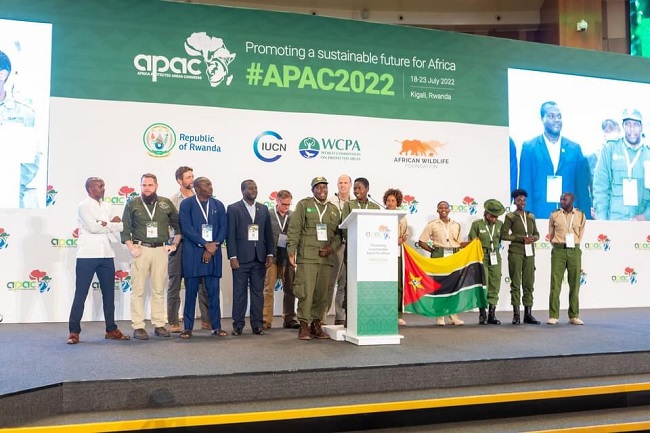BirdLife International has called for increased push for the safeguarding of protected and conserved areas at the IUCN Africa Protected Areas Congress (APAC) in Kigali, Rwanda. The congress – the first gathering of stakeholders focussing on protected areas – brought together more than 2,400 participants from 53 African countries to deliberate on the role of Protected and Conserved Areas (PCAs) in nature conservation, protecting Africa’s wildlife, delivering vital ecosystem services, promoting sustainable development while safeguarding cultural heritage.

Africa has about 6km2 of PCAs which provide food and water security, erosion and flood control, disease control, climate regulation, carbon sequestration and a host of other critical ecosystem services which underpin human welfare and wellbeing. However, these PCAs are grossly underfunded According to the IUCN, Africa suffers a shortfall of 80% to 90% on available funding for PCAs management.
At the congress, there have been calls for the development of a fund dubbed A Pan-African Conservation Trust (A-PACT) to help mobilise resources for the conservation of Africa’s PCAs, in addition to leveraging on other funding instruments including the Global Environment Facility (GEF), and Nature Africa programme.
“This inaugural APAC is an opportunity for stakeholders to link up and work in a coordinated manner to ensure resources and efforts go to the right places and for the priority efforts. For example, the discussion around investing in Key Biodiversity Areas identified as conservation priorities using standard criteria is a good starting point.
“In addition, the lessons shared regarding various innovative financing mechanisms discussed in the congress provide good opportunities. The BirdLife Partnership is working is supporting management of various protected areas and communities around them, an example being the Gola Landscape in Liberia and Sierra Leone,” explains Paul Kariuki Ndang’ang’a, Interim Regional Director for BirdLife International, Africa.
With the planet facing loss of 83% of animal species and 50% of plant species occasioned by human activities, the role of protected areas must be emphasized, and the BirdLife Partnership in Africa is championing In Southern Africa, for instance where BirdLife and partners are working to save vultures whose populations have declined by up to 97%, more than one million hectares of Vulture Safe Zones (VSZs) have been established.
Linked to this is the conservation of Key Biodiversity Areas (KBAs) which contribute significantly to the global persistence of biodiversity across terrestrial, freshwater, coastal and marine ecosystems. Under the Post 2020 Global Biodiversity Framework (GBF) currently under negotiations, one of the key aspects championed is the effective management of a scaled-up system of protected areas covering 30% of the planet’s land and ocean areas by 2030, which focus on KBAs and other areas of importance for biodiversity.
Indigenous People and Local Communities (IPLCs), play a prominent role in the conservation of PCAs. IPLCs are critical partners in helping achieve ecosystem protection, conservation, and restoration. By working with Partners and local communities through our “local to global” approach, we have demonstrated significant conservation success, which can be replicated in protected areas across the continent, by putting people at the heart of conservation.
In West Africa, MAVA Foundation, partnering with BirdLife International has made significant contribution to the conservation of protected areas in West Africa, which is home to critical habitats for endangered marine species and helped conserve priority coastal habitats, promote sustainable fisheries through minimising bycatch while strengthening local communities’ capacities to address conservation.
“MAVA has been key in empowering the BirdLife Africa Partnership in the region. We now have ten BirdLife partners in ten West African counties. In addition, we have a strong team of experts within the Secretariat for West Africa, split into three offices – in Dakar, Accra, and Sao Tomé. With a cross-cutting strategy for the conservation of birds and biodiversity, for the benefit of nature and people, we have an advanced and diverse projects portfolio for the region. Informed and innovative, relying on tools proven to be efficient, such as the Important Bird Areas, our Partners are involved in the protection of marine, coastal, and terrestrial landscapes.
“For instance, Nature-Communautés-Développement (NCD) is supporting the co-management approach of the Tocc-Tocc wetlands Community Reserve in North Senegal. The Society for Conservation of Nature in Liberia (SCNL) and Conservation Society of Sierra Leone (CSSL) are co-managing the transboundary Gola Forest landscape, between Liberia and Sierra Leone. Biosfera is supporting designation of new Marine Protected Areas (MPAs) in Cabo Verde. In Nigeria, the Nigerian Conservation Foundation (NCF) established the Lekki Conservation Centre in 1990 to serve as a biodiversity conservation and environment education centre in the country. Further, the BirdLife secretariat is co-managing the Obô Natural Parks of São Tomé and Príncipe.
“APAC has been an extraordinary opportunity to share our experience and put our actions into perspective, as we thank our financial partners, and in particular the MAVA foundation, for entrusting us,” explains Jean-Baptiste Deffontaines, Head of West Africa sub-regional office at BirdLife International.
A key outcome of APAC, which ended on Saturday, July 23, 2022, is the Kigali Call To Action, which calls for the identification, recognition and empowerment of all custodians of nature in Africa , including IPLCs’, women, youth, working with governments, civil society, and private actors to lead the way in conserving Africa’s rich biodiversity through protected and conserved areas.
Further, the Call to Action, underlines the need for more public and private financial investment in the conservation of protected and conserved areas, while championing the role of PCAs as nature-based solutions to tackle the twin crises of climate change and biodiversity loss.
